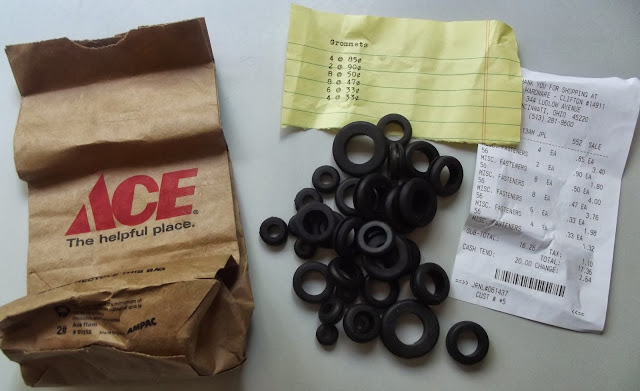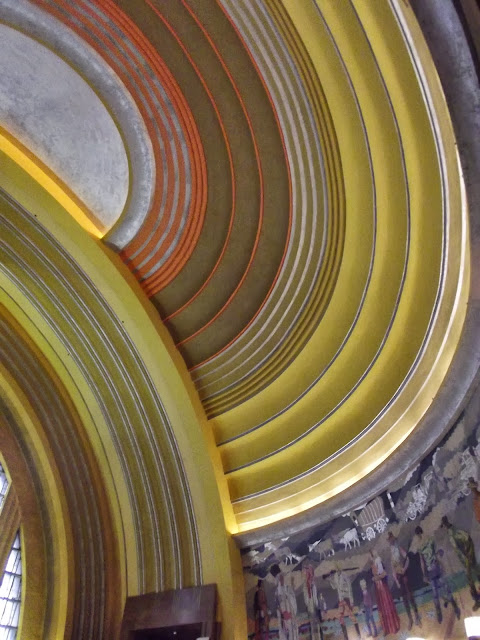At the end of a week in which I had savoured the delights of the Ohio Book Shop (where I was given a demonstration of old-style hot-type typesetting on a Ludlow Typograph in the bookbinding basement), the 17th century Arnold's Bar, with its Cherry Stout and delicious Bathtub Brew, Spitzfaden Office Supplies, with its cabinets full of typewriter ribbons, the Ace Hardware Store (aah, the grommets) and Sitwells Coffee House on Ludlow Avenue, the House of Adam (blue velour jacket) and Cincinnati chilli, there was still one last pleasant surprise left in store for me in Cincinnati.
Please note how well Richard typed for the cashier - using his Meteor portable typewriter in the hardware shop - a list of the grommets I'd selected.
On the day I flew out of Cincinnati, last Thursday*, Richard Polt picked me up from Clifton House (where I had commanded the entire the top floor, the Library Room, for four days) and we walked down Ludlow Avenue, the object of the exercise being to find a range of grommets not available in Australia (at least not in Canberra) at the Ace Hardware Store. After that we sauntered on to Sitwells Coffee House, a place of some historic typewriter significance, as the first Cincinnati Type-In had been held there a few years back.
Clifton House
The bedroom on the library floor
Then Richard taxied me along Ezzard Charles Drive to the magnificent old Cincinnati railway station, the Union Terminal, where he set me loose on a four-hour hunt through the museums of this truly wondrous amenity. I was particularly taken by the Cincinnati History Museum. The Natural History Museum had a kiwi skeleton and an example of this flightless bird's inordinately large eggs, but no identifying labels. On the upside a paleontologist took the time to stop her work, come out of her office and show how me she was piecing together a juvenile dinosaurs pelvis, explaining how the dinosaur had died, abandoned by adult dinosaurs, and why its bones had subsequently been scattered.
Inside the Cincinnati History Museum, one is greeted by a Model T and a vast scale model of the city, including the Union Terminal and City Hall, and a model railway system.
Further on, among the exhibits showing various stages of Cincinnati's history, are six typewriters, including a Bell Teletypewriter. 

Oliver No 2
I suspect a hole cut to allow the public access to the on-off switch, bottom right, has been sealed off.
There is also a Gibson & Co print shop, with a Cincinnati-made press, and type cases, the type of which inspired the QWERTY keyboard:
Above the type case here can be seen the leading case. Below, other exhibits included this tram which once served the area I stayed in, Clifton:
Dora Sowell of Soddy-Daisy, Tennessee.
As I waited outside the terminal for Richard to pick me up to take me to North Kentucky International Airport, to start my journey home, a woman with her elderly mother came out and commented very favourably on my blue velour jacket (see, it was worth buying, if only as a conversation starter!). When I replied, she picked me as an Australian straight away, explaining that she had visited Down Under.
One thing led to another and I was asked what I was doing in Cincinnati. When I started to talk about the typewriter collectors' gathering, the old lady enthusiastically chimed in, saying she just loved typewriters, had been surrounded by them all her life and still used them.
"Whenever I see one at a flea market, I can't resist it, I always buy it. I must have five or six now. I have one Underwood which I bought in 1936, and it was second-hand then."
Soddy-Daisy is a Tennessee town of 12,000 souls.
It turned out this lady was Dora Sowell, from Soddy-Daisy, Tennessee. Dora, who turned 95 in August, was born in 1918 in Córdoba, Argentina. Her father, Juan Sipowicz (1878-1959), was a legislature stenographer who became a teacher in English, typewriting and shorthand at the Universidad Nacional de Córdoba (founded 1613 and now the oldest and second-largest university
in Argentina, the fourth oldest in South America and the sixth oldest in
Latin America). Dora explained that in order to teach a Spanish version of Gregg shorthand, her father had to "invent" what is known in Spanish as "taquigrafía" (rather than simply translate Gregg).
Universidad Nacional de Córdoba
Just earlier this year, Dora said, a nephew in Vermont who is a house restorer was asked by a property owner to add a room to his home in which he could display 300 antique typewriters.
Dora was a nurse at a British hospital in Buenos Aires in 1940 when she meet and married American Maurice Judson Sowell, a DuPont representative. The couple and their four daughters moved to the US in 1951. Maurice died in Chattanooga in 1993, aged 81. Until fairly recently, Dora continued to teach knitting at the the Stone Light Studio in Soddy-Daisy.
All this was revealed to me in a charming conversation after a chance meeting with a lovely lady at an old railway station in the five minutes I stood there waiting for Richard to arrive.
It's an amazing world, full of amazing stories, a surprisingly large number of them related to typewriters. And the mere mention of typewriters today will very often bring out such great stories. Typewriters can act as a key which unlocks the fascinating pasts and connections of some people.
Richard Polt and a guy in a blue jacket.
* I am now back home in Canberra, having arrived here safe and sound at 10.30 this morning, Saturday, October 19. There was no Friday, October 18, 2013, in my life - it disappeared into the vapour somewhere over the Pacific Ocean, never to be regained. But since I had two Thursdays, October 10, 2013, and on the second of them met Richard Polt, I can hardly grumble. Thank you, Richard, last week was a truly unforgettable time in my life. And it was all because of you and the way you took care of me.













































.JPG)
8 comments:
It is an amazing world, Robert, as you rightly note. And your journalist's ear is as acute as ever. Thank you for relating some of this lady's life -- everyone deserves to be remembered somehow.
What a great report! Not only did you see several of my favorite places in Cincinnati, but you ferreted out stories there that I would not have found. Some people have "narrative attraction."
(I had some teaching and administrative duties to do while Robert was set loose in the city, in case anyone is wondering why I wasn't always there.)
Wow, amazingly small world!
"Taquigrafía" is still taught in schools, as far as I know, and I always assumed it was the Spanish version of the original shorthand method, but never gave much thought as to who developed it or when or where. Now I learned in a swipe that it was developed in Argentina, and that the inventor's daughter loves typewriters! Wow.
Thank you very much for the great posts! It was indeed a fantastic trip.
When I lived in Ann Arbor, Michigan and would drive to visit family in Birmingham, Alabama, I would often pass through Cincinnati. Thanks for showing me the wonderful city I never stopped to enjoy.
I'm glad to hear you are safely home. And the blue jacket, with its present of that wonderful conversation with Dora Sowell of Soddy-Daisy, has certainly paid for itself.
Excellent trip report. I think I need to plan a trip North one day next summer. Those are some fantastic places.
Great report, Robert. I've taken the family to that museum complex several times, and it's always a good time.
(But not as exciting to me, personally, as that series of tw ribbon drawers at Spitzfaden's!)
Glad you made it back safe! Thanks for another awesome blog post!
Post a Comment